Please use the following link to download the September 16, 2023 issue of the syəcəb
Author: Kim Kalliber
Curating culture in the City of Kenmore
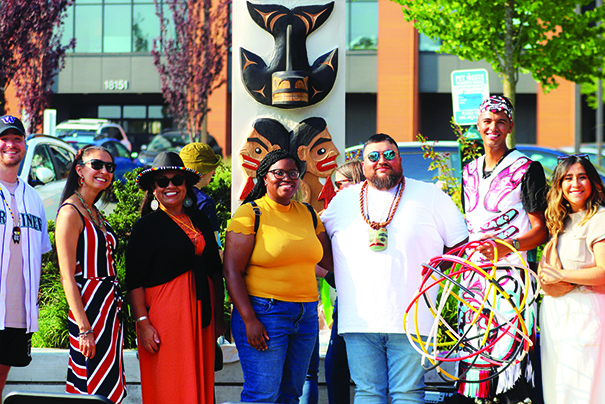
By Micheal Rios, Tulalip News
Slightly less than an hour’s drive from the Tulalip Reservation, going southbound on I-5, one can find the City of Kenmore. A relatively small city with an estimated 24,000 residents, it’s a suburban town that occupies the land where the Sammamish River joins Lake Washington.
Native Americans were the only people living in what is now the Kenmore area as recently as two hundred years ago. They lived on the waterway that later became known as the Sammamish Slough. It’s not difficult to imagine these Coast Salish ancestors establishing multiple villages in such a pristine fishing and hunting area, with each village having one or more cedar-plank longhouses to hold village families.
According to the Kenmore Historical Society, it was a great place to live, to fish, and to hunt. Migrating salmon entered the lake from the sea and swam to the mouth of the Sammamish Slough. Ducks and geese were abundant, landing in nearby marshes and the estuary on their annual migrations. Game was plentiful, and the area supported large populations of otters, beavers, muskrats, and other animals.
Flash forward to 2023, and that stunning Coast Salish identity that once thrived on those pre-colonized Kenmore lands is actively being curated once again by modern-day culture-bearers. The latest example of this reclamation process occurred just this summer as a special story pole awakening ceremony kicked off the city’s 25th anniversary celebration.
Installed in the heart of the town square and unveiled during a city-wide celebration is a towering 12-foot story pole created by Tulalip artist Ty Juvinel.
“I get asked the question often, “What is a story pole?” because people think we only made totem poles. When, in fact, our Coast Salish ancestors of this region made story poles and house poles,” shared Ty. “The difference was that a house pole was kept inside, while story poles were placed outside and were of utmost importance in acknowledging a nearby longhouse.
“I’ve been told there used to be a longhouse where the town hall used to be,” added the 36-year-old culture bearer. “The meaning behind this story pole actually explains the meaning of why Tulalip’s logo is the killer whale. The inspiration comes from the traditional story Seal Hunter Brothers as told by Lushootseed legend Martha Lamont. Further inspiration for this pole’s design and carving style was to intentionally reflect the style of [last hereditary chief of the Snohomish Tribe] William Shelton and the story poles he created.”
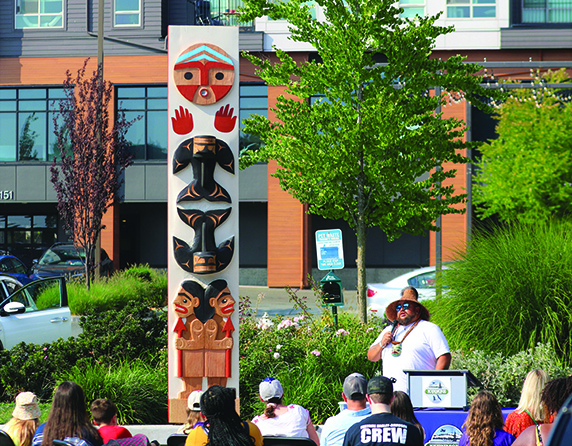
Ty spent hundreds of hours over the course of months to create this awe-inspiring story pole that started as a 12-foot tall by 30-inch wide single Cedar beam procured along the peninsula.
At their core, story poles are cultural storytellers. They are meticulously carved from large, straight cedar logs – chosen for their durability and resistance to decay – using various handheld tools. The intricate designs and figures adorning the poles are then carefully painted with earth tone or Medicine Wheel pigments.
Each story pole narrates a unique story, most often detailing a tribal village’s history or an iconic narrative that’s been told for millennia. They are central to preserving and spreading traditional teachings passed on via the oral tradition, a key aspect of Coast Salish culture.
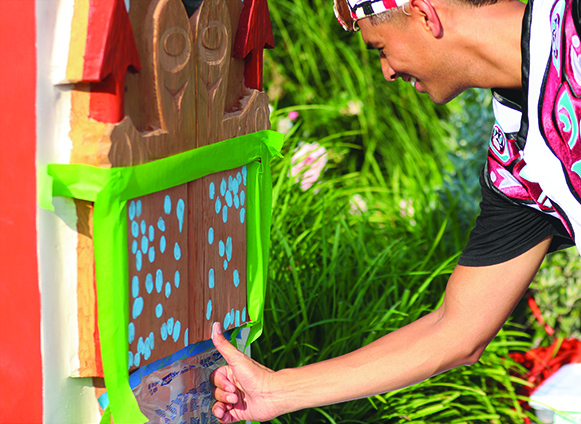
In that vein, it’s become an artist’s signature for Ty to welcome members of the local community to leave a lasting mark on his story poles to both solidify allyship and serve as a reminder that they heard the pole’s story and can be held accountable to pass on the teaching. He achieves this by inviting all those in attendance at the story pole’s awakening to leave their painted thumbprint on a dedicated panel at the pole’s base.
“It solidifies the story pole being welcomed into the community. There isn’t a lot of opportunity for people to engage with art or our culture, making it much more memorable for those who leave their fingerprint,” said Ty. “Twenty years from now or even longer, those who were here might return, and when they do, they’ll be able to spot their print and, hopefully, remember what they witnessed and tell others about it.”
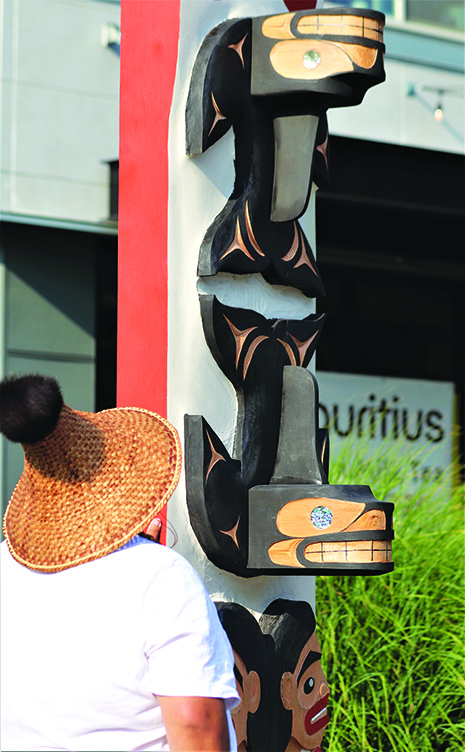
Coast Salish story poles are so much more than wooden sculptures, they are living embodiments of Indigenous history, culture, and spirituality. With their roots stretching back millennia, they stand as a testament to the resilience and enduring traditions of the region’s first peoples. As they continue to be celebrated and respected, their stories, like Martha Lamont’s Seal Hunter Brothers, will echo through the ages, ensuring that this tradition remains alive for generations to come.
Discipline is key: Dylan Jones-Moses has his eye on a future in law enforcement
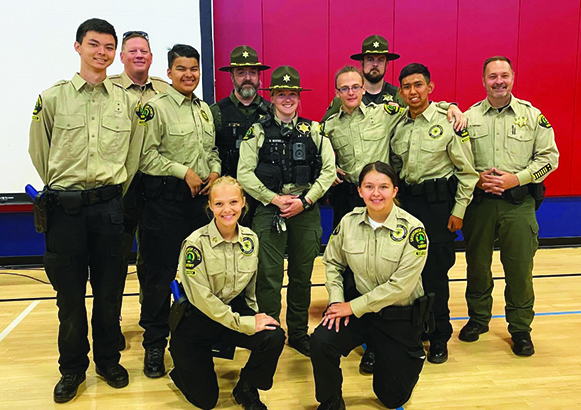
By Wade Sheldon, Tulalip News; photos courtesy of Moiya Leger Rossnagle
When many kids are focused on friends and the latest trends on TikTok, a unique program offers the youth of today a chance to learn what it takes to become a police officer. The Snohomish County Sheriff’s Explorer Program provides a real-life look at what it’s like to pursue a career in law enforcement. Early in March 2023, 16-year-old Dylan Jones-Moses, a Tulalip tribal member, decided to enter the program.
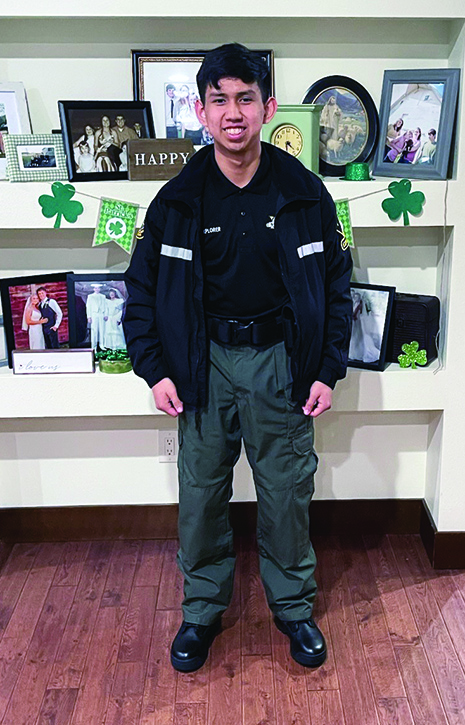
The Explorer program, open to students aged 14 to 20, teaches about the laws and procedures for being a police officer. Explorers participate in real-life law enforcement scenarios, learn how major investigations are conducted and visit dispatch centers and county courthouses. They can even volunteer their experience at community events, conducting traffic control, providing security, and working with crime prevention programs. There are also opportunities to attend law enforcement competitions and conferences. Explorers spend a minimum of 10 hours each month in the program, and can continue until high school graduation and beyond.
“I went to the primary academy, which was challenging but a great experience,” said Dylan. “Going through the Explorer program has taught me a lot. It’s taught me to stay orderly, be disciplined, and not give up.
When asked what he thinks is the best part of the Explorer program, Dylan replied, “I would say seeing each other work as a team or a platoon. Coming together to overcome certain obstacles or reach specific goals was fun. It’s also a great experience to see what boot camp feels like. They teach a lot of good stuff, and it’s positive for people my age. After graduating, I want to go into the Army or stay in the Explorer program and become a police officer.
Moiya Leger Rossnagle, Dylan’s adopted mother, explained, “His dad, Shane Moses, and his family are very proud of his accomplishments. This has been a tremendous opportunity for him to have some training. All the Sheriffs at the academy have been friendly while building encouragement and hard work into the kids. This program has been very motivating for Dylan; with this course, he can utilize his discipline.
If you want to know more about the Snohomish County Sheriff’s Explorers, visit Snohomish County Washington at https://snohomishcountywa.gov/3534/Sheriffs-Explorers.
Krislyn Parks weaves together the past, present, and future into her Salish skirts
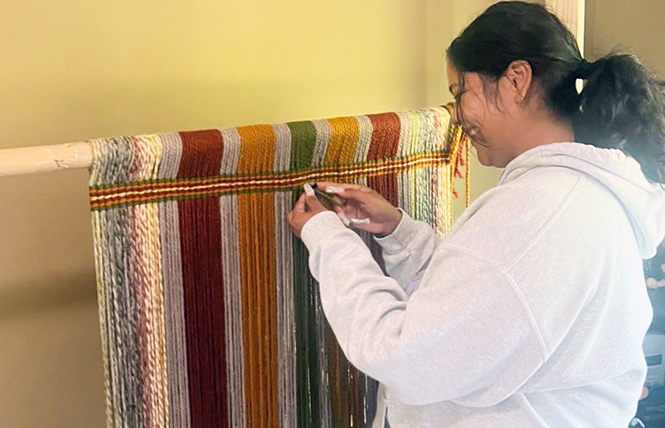
By Kalvin Valdillez, Tulalip News
Long strands of intricately woven wool sway vertically at the bottom of a traditional Coast Salish skirt. Across the top is a horizontal pattern that creates the skirt’s waistband, which often features Salish designs or accessories such as shells and buttons.
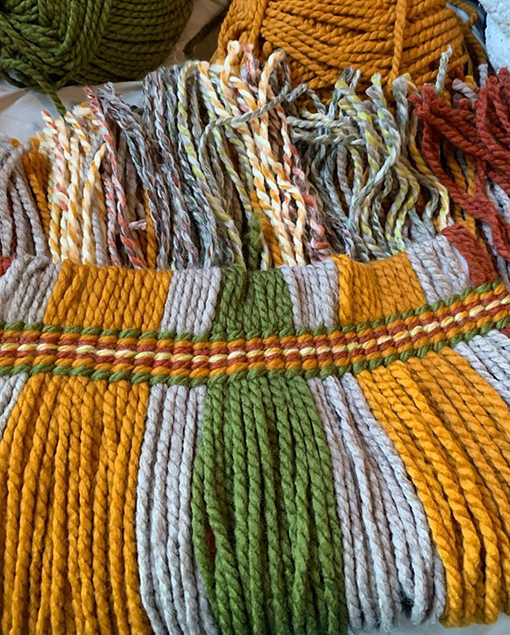
The skirts were a necessity pre-colonization and are now often overlooked by the general public, thanks to some of our other masterful creations such as blankets, shawls and cedar weavings. However, the Coast Salish skirt played an intricate role in the lifeways of our women ancestors. For the skirts provided warmth throughout the cold fall and winter months, and also served as ceremonial attire during traditional gatherings.
Native America is currently experiencing a powerful and important ribbon skirt resurgence. Locally, more and more women from coastal tribes are contributing to what could be the start of a new revitalization movement by wearing wool skirts to ceremonies and as a part of their OOTDs (outfit of the day). These ladies also often alternate between ribbon and wool skirts, to show their continued support of the ribbon skirt initiative.
Although new to the game, Tulalip tribal member Krislyn Parks has found a passion in creating traditional Coast Salish skirts. Her handmade textiles with exquisite color schemes are bringing more attention to a practice that was nearly lost during the assimilation era, while also putting a her own spin on it.
After coming across her beautiful work, on her Instagram business account, Tulalip News reached out to Krislyn to chat about her newfound passion, it’s history, and what she hopes to accomplish through her handwoven skirts.
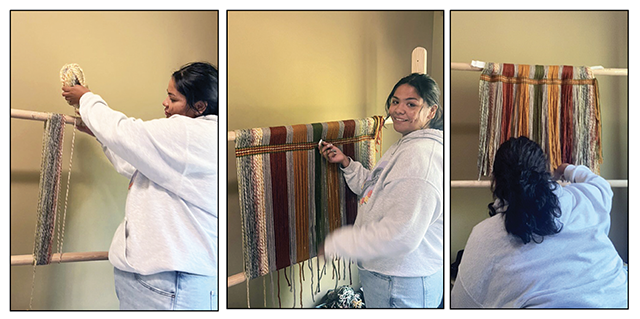
Tulalip News: Why don’t we start by learning a little bit about you?
My name is Krislyn Parks. I am 20 years old. I’m Kristie Fryberg and Jared Parks’ kid. My grandparents are Karen Fryberg and Cyrus Fryberg Sr., and Beatrice Forman and Leslie Parks. I’m proud to be Tulalip because it roots me down here from generation to generation. I have family ties here and I think it’s important to learn about my people and who I am. And be proud of who I am – express my culture and show everybody what it means to be Tulalip and who we are today.
What are some of the cultural practices that you take part in?
As a kid, I always took part in canoe journeys and sweat lodge, my dad’s side of the family always participated in that. And as I’ve gotten older, I was taught how to bead by my auntie Winona Shopbell and uncle Bubba Fryberg. My grandma Karen taught me how to sew at a young age so I could make my regalia. And I picked up weaving when I joined the Lushootseed department. Michelle Myles sat down with me a couple of days and just weaved with me, showed me how to do it and got me interested in it.
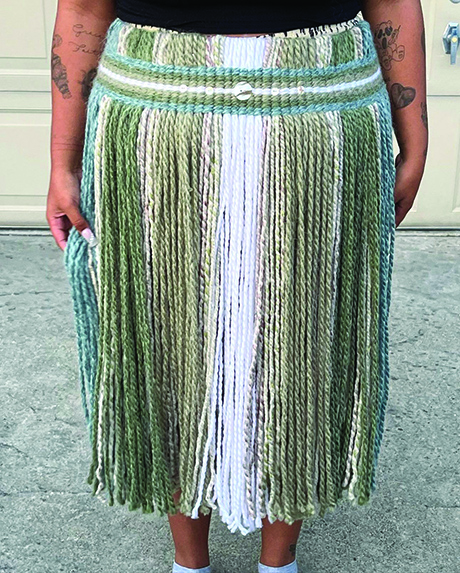
That’s awesome! Can you talk to us about the wool skirt and it’s history?
The wool skirts were something that we would wear during the cold time. Just to keep us warm, our women would be weaving all the time, that was one of our jobs. I’ve weaved cedar before, but weaving with fabric was new and really interesting. And so was learning about the woolly dog.
The story about woolly dogs is fascinating. Can you tell our readers more about the woolly dogs?
Our people used to have our own island that we used to take care of. Our ancestors, the women of the families, would go out onto the islands and take care of our woolly dogs. They would process their wool into the yarn used for skirts.
That shows how strong our ancestors were. To me, it’s always about recognizing how much they put into their work and how much love they put into it. They didn’t get to go to the store and buy yarn. They had to breed that type of dog, take care of them, and then they would shave the wool off the dogs every season. They would then pull it, spindle it in a whorl, and turn it into its own yarn.
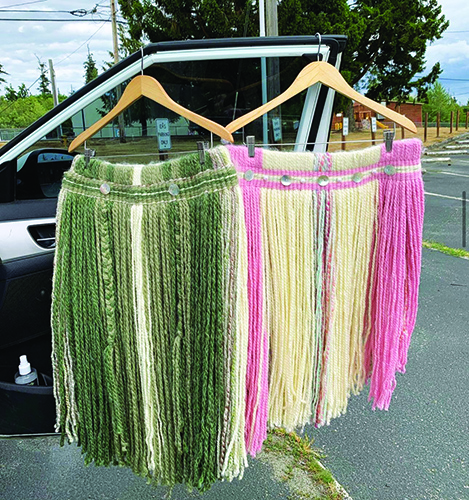
Now that woolly dogs are extinct, what type of wool do you use in your work?
I use alpaca wool instead of woolly dog because – well, because we can’t get any of that anymore. We can never get that type of wool back, but we can keep preserving the tradition in different ways by showing and telling people about that kind of wool compared to the kind of wool we are using today.
You mentioned that you picked up the practice from Michelle Myles, can you expound on the beginning of your weaving journey?
When I started, I learned everything at the Lushootseed department. We had looms that were donated to us that were kind of old and broken down. But, we decided to work with them. And really, we just picked it up while preparing for language camp, to teach the kids about weaving and how to do it.
In our department we always say that we can’t just teach the kids and not practice the work ourselves. I teach weaving in the winter because that’s when our ancestors would weave at Tulalip. And my first time teaching that weaving unit, it was hard to connect with the kids. Learning how to weave this summer will make that weaving unit a lot easier. Now I’ll be able to bring in the loom and show the kids how to warp up their own weavings and make skirts for the classes, which I’m really excited to show the kids this year.
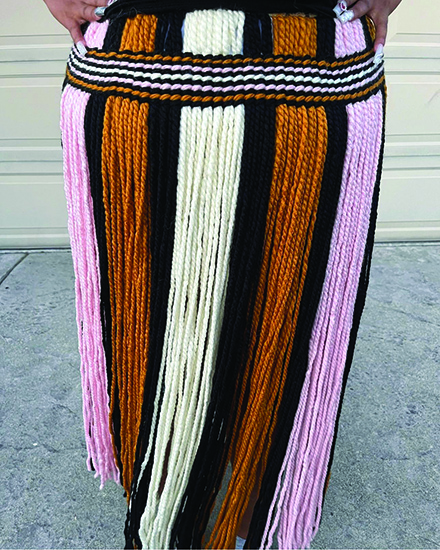
Now that you’ve learned how to weave wool, can you explain your process of creating a skirt?
Weaving wool skirts is really calming for me. I typically do it at home now, I have my own little weaving station setup in my room. Once you have your wool, you’re going to setup your loom and it’s going to need to have two bars on it. And then you’re just going to start warping the wool, just wrapping it around the loom. For an adult sized skirt, I would wrap it around 200 times, warping it up on the loom so it looks like a flat map. And then, I would take individual sections by two and just weave. Then I’ll twist through every two pieces and that’ll will be like me creating the design. It’s definitely all about the twining.
We heard that you paid homage to Barbie through your skirt designs. Let’s hear the deets!
We did! During the Barbie movie release, Marysa Sylvester did an Indigenous Barbie shirt and I bought it. So, I was like I need to make a skirt! Me and my coworker both made Barbie-themed pink and purple skirts and we raffled them off as a part of a Barbie raffle. It was so much fun.
When I was growing up, there were Indigenous Barbies that Mattel put out and they were in powwow regalia. So, we were talking about making dolls with some wool skirts for our classes because it would be nice to show the kids our representation. To show not only what a Native American Barbie looks like, but what a sduhubš, Snohomish Tulalip, Barbie would look like.

Since you started this new endeavor and you now have skirts available for purchase, have you seen any of your skirts in the wild or during a ceremony?
I’ve had a few so far. I made a skirt for myself and I ended up letting a friend have it, and she wore it to a jam that was happening that night. It was also really awesome to see a couple little girls and my old coworker walking around in my skirts and dancing in my skirts, when I know that they would’ve otherwise worn ribbon skirts. I’m glad that they’re culturally getting down, and are enjoying it and representing it with pride. I think that’s such a beautiful thing.
You are not only learning about wool weaving and how to do it, but you’re also passing down that knowledge to the next generation. What does it mean to you to carry on this tradition?
For me that means being open to share with anybody who is wanting to learn. Since I’ve learned and picked this up, I’ve had many of my own family members asking me to to host a class and teach them how to do this. I think that really shows how open our tribe is to learning things, we just don’t always have access to it. I think by me doing this, it’s granting more opportunities for other people to feel comfortable expressing their culture.
As you continue to practice this tradition, what do you hope to see in the future for your skirts?
I hope to see other kids find this way of life and that they show me how they practice it. This is something that our people dedicated their lives to, and there’s reason for that. It’s always going to be my main goal to see somebody I taught speaking the language and practicing all the arts our people did.
Where can people find your work and purchase your weavings?
On my Instagram account, @krislyns.kreations, or on Facebook under Krislyn Jo. Those would be the best ways to reach me. I know that every Native got some type of social media, so that’s the way for right now.
September 9, 2023 syəcəb
Please use the following link to download the September 9, 2023 issue of the syəcəb
Club kids team up with cops for excitement-filled Rocket League tournament

By Micheal Rios, Tulalip News
In communities nationwide, a remarkable shift is taking place to emphasize trust and understanding between urban youth and their local law enforcement agencies. The power of these positive interactions cannot be overstated, as they have far-reaching and, sometimes, even life-changing benefits for the community and the officers who serve it.
At the heart of this shift is an improvement of community relations. Building positive interactions between youth and law enforcement may seem like a daunting task, but it can be achieved with something as simple as a video game tournament. Such was the case in late August at the local Tulalip Boys & Girls Club, where the first of its kind ‘gaming with a cop’ tournament brought together youth from all around Snohomish County and their local police officers.

“This event was the culmination of weeks of planning and preparation by multiple Boys & Girls Clubs who wanted to ensure our kids ended their summer break with a fun, exciting, and truly memorable event,” explained Club Director Shawn Sanchey. “Each club had multiple practices, partnering up two club kids and a cop as a team to compete in a Rocket League tournament.
“This has most definitely reached the top tier level of just pure excitement in regards to the activities and events we’ve hosted. After seeing all the excitement and how much enthusiasm we got from both the kids and the cops, it’s obvious we need to continue to grow upon this success and keep the community engagement going,” he added.
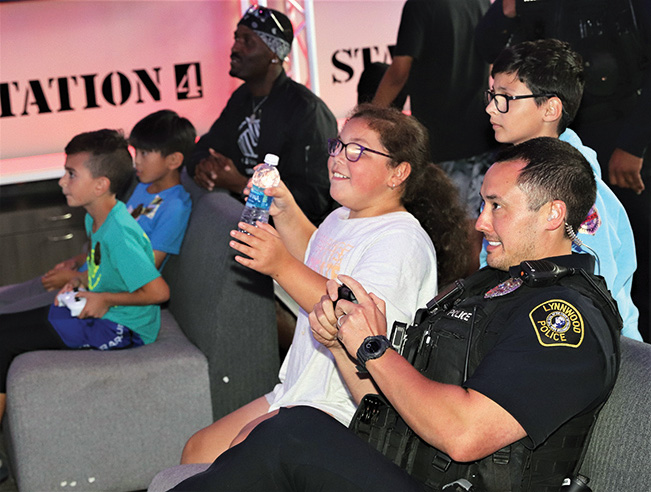
Once the actual e-gaming tournament kicked off, law enforcement representatives from Arlington, Everett, Lake Stevens, Lynnwood, Mukilteo, and Tulalip were swept away by the youthful spirit that filled the B&GC Teen Center. The dedicated first responders found themselves swimming in a sea of contagious competition, where they weren’t alone. They had their teenage teammates as life preservers, carrying them to one score after another in an X-Box-based digital landscape.
For those unfamiliar with Rocket League, it’s a high-powered hybrid of arcade-style soccer and vehicular mayhem with easy-to-understand controls and fluid, physics-driven competition. Still not picturing it? Well, just imagine you and two friends are playing a soccer match against another team of three, except you’re all driving cars. Got it? Good.

Promoting positive interactions between youth and law enforcement goes a long way to building trust, respect, and an open line of communication within our 22,000-acre reservation. By doing so, it reduces the likelihood of misunderstandings, conflicts, and negative stereotypes, leading to a more harmonious relationship between Tulalip’s law enforcement and its growing residential population.
“Being a part of the community response team within the Tulalip Police Department, when I heard of this idea to join up with youth to compete against other cities, my initial reaction was what an amazing idea,” shared Officer Carrington. He’s served TPD for over three years now. “For me, being able to create positive interactions with kids and let them know that our priority is to protect them was why I wanted to become a cop in the first place. Being able to spend time with them in a fun setting, share stories, or even just hand out stickers can create moments that last a lifetime. I know I won’t ever forget this day.”

Positive interactions with law enforcement inspire young people to consider careers in law enforcement or related fields, which can help to diversify and strengthen the future of community policing locally. Experiences shared during the Rocket League tournament may have empowered a young individual or two to dream of becoming a cop one day, especially if it means leading an e-gaming team to victory one day.
Twelve-year-old Israel Ford was the living embodiment of this notion as he was routinely seen asking cops from each agency for those impossible-to-miss gold-colored, sticker badges. At one point, his white t-shirt was covered in them. “These are my badges of honor,” he declared to all those within earshot. His vibrant energy and collection of gold badges helped fuel his three-person team to the tournament title, and gold 1st place trophy.

“This was so much fun. Our cop carried us to the championship. He was really good and caught a lot of teams by surprise,” said 14-year-old Ashton Bullock of the tournament-winning Mukilteo team.
As it turned out, Adam Hodges, community resource officer for the Mukilteo Police Department, was a Rocket League sleeper. He admitted to having more than 2,000 hours played, which served him well in eliminating one team after another.
“These new age video games require so much brain power, hand-eye coordination, and team strategy in order to be successful,” said Officer Hodges. “Me, Ashton and Izzy played quite a bit in the weeks leading up to today so we could learn each other’s playing styles. This win comes with a lot of bragging rights, for sure, but more importantly, it comes with a bunch of shared memories filled with laughter and excitement. In a way, that makes everyone who participated in this tournament winners.”

Tulalip observes National Overdose Awareness Day in a good way
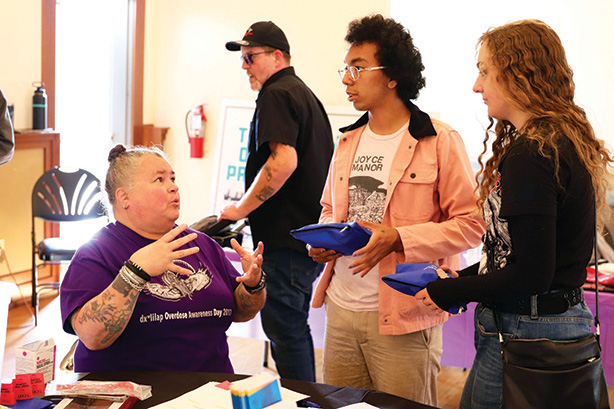
By Kalvin Valdillez, Tulalip News
Laughter has an infinite amount of healing properties. This is especially true in Native America. Nothing lifts your spirits more than a teary-eyed elder who is cracking up, or a 100+ decibel cackle by a rezzy auntie.
There was plenty of laughter to go around at the Tulalip Dining Hall on August 31, as the people enjoyed each other’s company and painted vibrant colors on small canvases throughout the afternoon. Because of the dining hall’s acoustics, the laughter bounced off the walls and amplified the good vibes on what otherwise would be a solemn gathering.
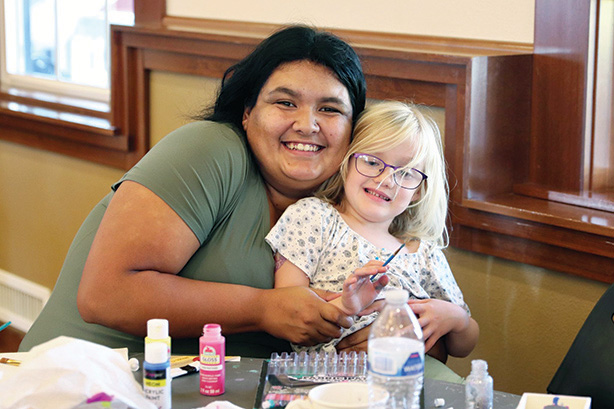
Purple streamers hung from the ceiling and tables were placed throughout the hall. There were a handful of tribal departments in attendance including the Recovery Resource Center, Behavioral Health, Quil Ceda Creek Counseling Company, Tulalip Community Health, and the Healing to Wellness Court. They setup shop with resources at the ready for those looking to attain or maintain their sobriety.
Although the tables were occupied by artists, staff and community members who grubbed down on the Panera catered dinner, one table stood alone at the far end of the room. And though we established that laughing can help those who are on a healing journey, the attendees still approached this table with a great deal of respect, as if it were a sacred space, and offered silent prayers.
After viewing the large poster at the center of the table, the event goers painted the palm side of their hands with the color of their choice and placed it on the margins of the banner, in remembrance of their loved ones who lost their battle with addiction.
“My uncle Blake passed away in June from an overdose. He was my favorite uncle,” said Tianna Moses with a heavy heart. “Today, I painted my hand and put my handprint, along with my uncle’s name, on the poster.”
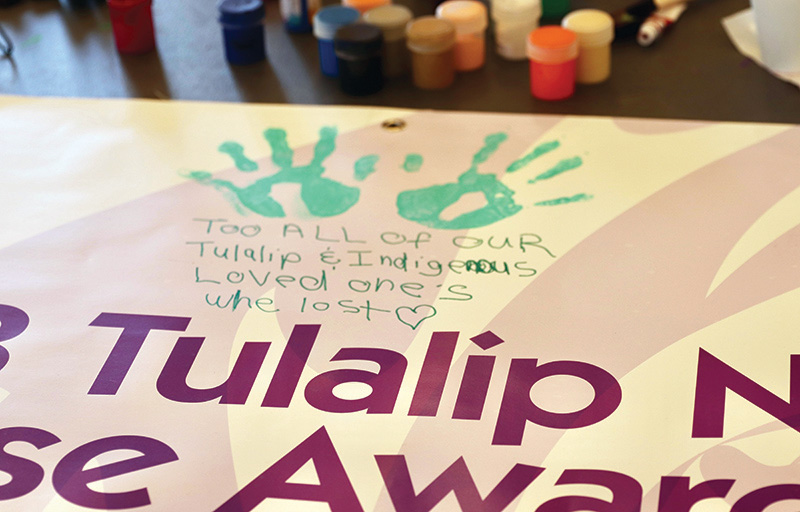
Communities across the country observed National Overdose Awareness Day as the opioid epidemic continues to spiral out of control. At Tulalip, the day is dedicated to honoring those friends and family members who are no longer with us due to overdose, as well as educating the community by providing resources, tools, and open arms.
“It is important to remember and recognize all of our loved ones who lost their lives to overdose, or in relation to substance use disorder,” said Tulalip Recovery Resource Center Program Coordinator, Kali Joseph. “It’s such a heavy topic, and it’s one of those things that we sometimes stay silent about. It involves lots of grief, and disenfranchised grief, but it is important to talk about and remember our loved ones.”
National Overdose Awareness Day also provides the chance for the local recovery community to strengthen their bonds together and continue to build a strong support system with one another. Over the past few years, the Tulalip recovery scene has grown in numbers, so much so that this year’s Recovery Campout tripled its participants from last year’s inaugural excursion to Lopez Island.
Said Tashena Hill, Recovery Resource Center Outreach Specialist, “We did the camping trip which was a huge turnout, we had over 70 clients there and they all had a whole lot of fun. Being somebody who’s in recovery, you have to find what fulfills that dopamine and gives you that umph again, so you’re able to have fun. Because if you can’t have fun in life, you’re not happy. And if you’re not happy, you’re more susceptible to going back out and using. That’s why we’re doing fun events. We’re also starting classes up at our building that are focused on things like creating job resumes.”
Kali added, “One of the biggest things that prevents relapse or recidivism is having a good social support system. When you’re surrounded by other people who understand what it’s like to be in recovery, it teaches you how to have sober fun together. And it lets you know that you’re not in this alone because there’s a lot of stigma and shame associated with addiction.”
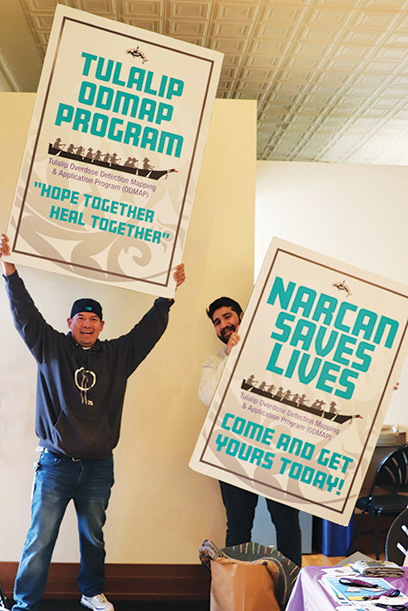
Upon entering the dining hall, each person received a Narcan kit. The overdose reversal spray is relatively easy to administer and has saved countless lives. Narcan is readily available at the Tulalip Health Clinic and the Tulalip Behavioral Health center. The Recovery Resource Center also frequently holds Narcan distributions throughout the reservation. And just recently, the program unveiled a new vending machine at the Pallet Shelter that is stocked with Narcan, as well as fentanyl test strips and hygiene products.
“I overdosed two times when I was using, so I’m thankful for Narcan,” shared Tianna. “I think everybody should have it and be prepared, because Narcan really does save lives.”
“We’ve heard from numerous clients that Narcan has saved their lives – that if they didn’t have it on hand, they wouldn’t have made it,” Tashena stated. “It’s important that people know that it’s out there now and it’s easily accessible. A life can be saved. Some people didn’t have it on them, and that’s what that handprint poster represents. It’s for the people who we lost, and if they had Narcan that day, they’d still be here with us. We hear it over and over again, ‘I wish I had Narcan that day’.”
Kali explained, “Narcan is important because it can reverse an overdose. It is like a downstream approach to prevention but it’s important because it will save the person’s life right then and there. It opens up more windows of opportunity for that person to get sober and live a better life. And it gives them more hope and time to decide that they are ready to change their lives.”
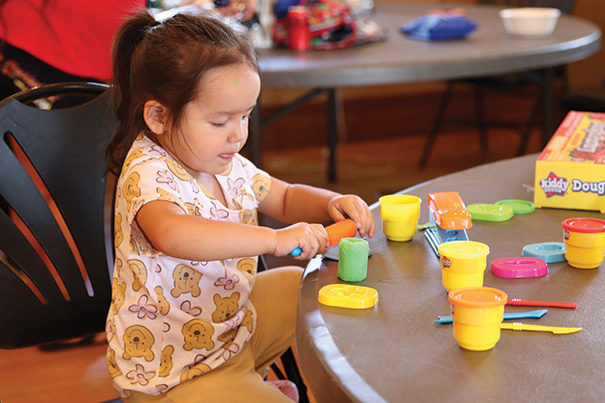
According to the Snohomish County Opioid Overdose and Prevention Data and Dashboard, there were 215 overdose deaths in the county last year, an increase of 115 people when compared to 2017’s statistic of 100 deaths by overdose. And the most recent data shows that this year, at least 66 people have died due to an opioid overdose in the first quarter of 2023.
There have been numerous studies throughout the years, from the likes of the CDC and Washington Post, that show Native communities have been hit the hardest by the opioid crisis. The Albuquerque Area Southwest Tribal Epidemiology Center’s (AASTEC) research indicates that in 2021, the opioid overdose death rate for Natives was 38.7 deaths per 100,000 nationwide.
With this current trend, the epidemic shows no signs of slowing down. Even so, Tulalip is taking proactive measures by offering multiple programs and resources that are dedicated to helping their membership gain their sobriety and live a clean and healthy lifestyle.
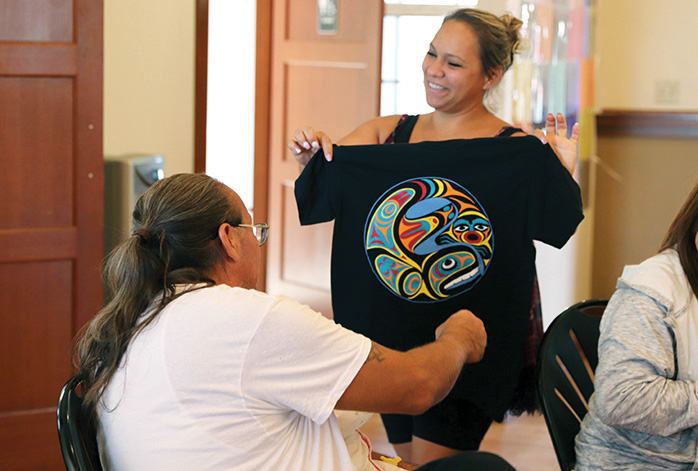
The event concluded with a raffle, in which people won items such as Coast Salish laced t-shirts, mugs, and blankets. The National Overdose Awareness Day event was a lighthearted gathering where the community reminisced about their late loved ones and honored all those lives lost due to an overdose.
Tianna expressed, “I wish there were events like this happening when I was using, so I could’ve seen that there are people who care and are really out there to help. I was in active addiction for almost eight years, I’m 25 so that’s a long time. I never thought I would be sober again. I thought death was going to be my only way out. And that’s why this event is important, because it spreads awareness, and it shows people that we can recover.”
For additional information, please contact the Tulalip Recovery Resource Center at (360) 716-4773.
Facing the opioid crisis
First ever National Tribal Opioid Summit held at Tulalip

By Wade Sheldon, Tulalip News
Leaders from the Tulalip Tribes, coordinating with the Portland Area Indian Health Board, hosted the first-ever National Tribal Opioid Summit at the Tulalip Resort and Casino, August 22-24. With assistance from the White House Office of National Drug Control Policy Director, Dr. Rahul Gupta, the group is working to create pathways for more resources and to better understand what is happening in communities all over the United States.
“This is a problem that has two sides to it, there’s a public health and public safety side,” Dr. Gupta explained. “Any given day in this country, we have about 2,000,000 people incarcerated and 95% will get out. 60-80% are in there because of drug-related use. It’s a huge issue. We figured if we just remand people who are addicts, the problem would go away; it just hasn’t. In fact, they are 120% more likely to die from overdose when released. If someone has a problem with mental health or addiction, they should be getting the help instead of being incarcerated.”
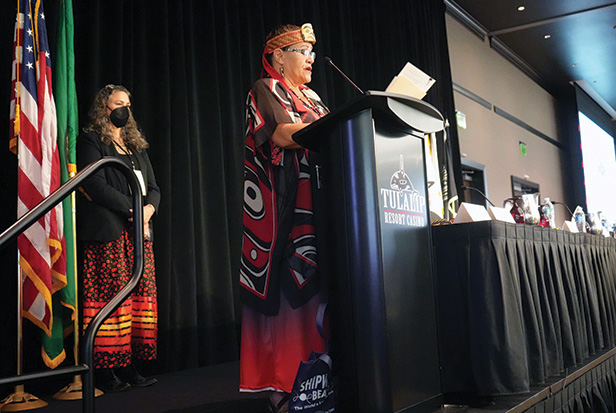
“I came from a much larger city, and I have to say without a doubt, the disproportional impact on tribal communities is significant,” said Chris Sutter, Tulalip Police Chief. “We have learned that we cannot do this in silence. We are never going to arrest our way out of this problem. We are looking into Tulalip’s long-term vision: how can we reinvent the rehabilitative incarceration system that focuses on the well-being of the person, not just locking them up but helping them become long-term citizens when they come home.”
Throughout the 3-day event, several discussions were held on how to help and heal people with addiction. The public health crisis has leaders from several tribal nations coming together in search of answers when dealing with the opioid epidemic. Some problems addressed were fentanyl, overdose rates, prevention, and mental health. The National Institute on Drug Abuse says, “Many individuals who develop substance use disorders (SUD) are also diagnosed with mental disorders, and vice versa.”
This has led to a whole new approach when dealing with someone who is currently in addiction. New methods have been developed and implemented to help address mental health as well as the body. People trapped by drug addiction are finally being listened to. New facilities are being built to handle the needs of people in addiction and help them find a better solution to how they live while giving them a way to manage their lives.
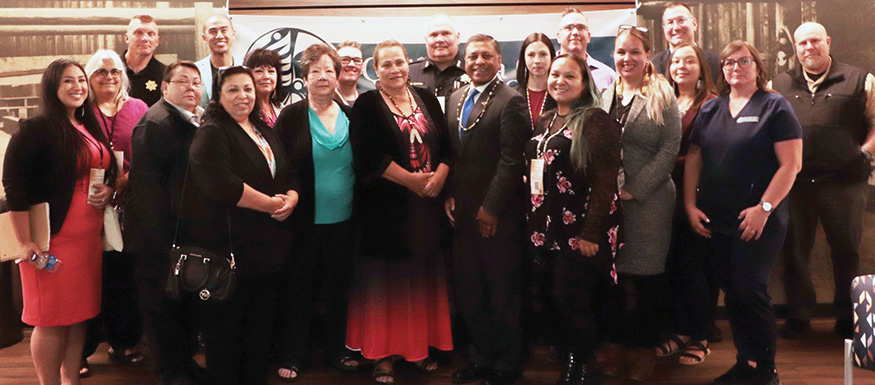
One of the many facilities battling the opioid epidemic is the Quil Ceda Creek Counseling Center (Q4C). On a tour of the facilities with Dr. Gupta, Tanya Burns, Q4C Administrator, stated, “For our intensive outpatients, we use a whole person approach for helping people who are in addiction get medication-assisted treatment with primary care, group therapy, counseling, resource referrals and childcare services.”
“The intention was to offer as many things under one roof as possible,” Tanya said. “When you refer people in addiction out for different services such as counseling or to see a primary care doctor, you have no way to confirm they will go or can go. So, if we can take care of that here, we have that confirmation and can diagnose them or help assist them with finding treatment. We also offer Narcan to new patients, and anybody can walk through our doors and get Narcan for free.”
If you or someone you know are facing issues dealing with addiction, you can contact the Quil Ceda Creek Counseling Company at (360)716-2211.
September 2, 2023 syəcəb
Please use the following link to download the September 2, 2023 issue of the syəcəb
Coast Salish swag takes over T-Mobile Park

By Micheal Rios, Tulalip News
It’s impossible to know how many Native Americans attended the Seattle Mariners vs. Oakland Athletics baseball game on August 28. But what we do know is the official attendance for the Monday night game, dubbed ‘Salute to Native American Heritage’ night, was announced as a whopping 37,434 people.
And a nice chunk of that thirty-seven grand were citizens of Pacific Northwest tribes who journeyed to the Emerald City hours before first-pitch to get their hands on a highly coveted, limited-edition jersey created by Muckleshoot tribal artists. It was impossible to miss the intricately detailed beaded medallions, always striking cedar woven hats, and various forms of turquoise jewelry that visually proclaimed, “Our culture is alive and thriving!”

Lines wrapped around the multiple stadium entrances with anxious fans who wanted to be wrapped in a navy blue and Northwest green colored Mariners jersey that featured Coast Salish form line. Only the first 10,000 fans received the first-of-its-kind jersey.
Prior to first pitch, the Muckleshoot Canoe Family took to the always stunningly manicured green grass of T-Mobile Park and shared their culture through dance and song accompanied by traditional hand drum beats.
Throughout the evening, the Mariner’s 11,000-square-foot scoreboard routinely displayed facts about Indigenous tribes of Washington. One example read: “There are more than 30 tribes throughout the state of Washington and over 140,000 Native American citizens in the state alone.” Another read: “Chief Sealth or Chief Seattle was a Suquamish and Duwamish chief respected for his peaceful ways and is the namesake of the city.”

During actual gameplay, the Mariners, who recently took 1st place in their division for the first time in 20 years, gave their adoring fans much to cheer over 9 full innings. Center fielder J.P Crawford hit a 394-foot homerun in the Mariners’ first at-bat of the opening inning. The home team jumped out to a 1-0 lead and never looked back.
Franchise phenom Julio Rodriguez added to the excitement by crushing a two-run, 420-foot bomb in the 4th inning. He finished the game 4-5 with 3 runs scored and 3 RBI. During a postgame interview, Julio said, “It’s really good. I feel like everybody is playing like we all know we could,” Rodríguez said. “It’s been really good seeing everybody having fun, seeing everybody getting good at-bats and getting on base and passing the baton, and getting the big hits when we need them.”

Ultimately, the M’s won a memory-filled, 7-0 shutout in front of the largest Monday crowd they’ve had all season. Adding to the legendary game that was, ‘Salute to Native American Heritage’ night.
